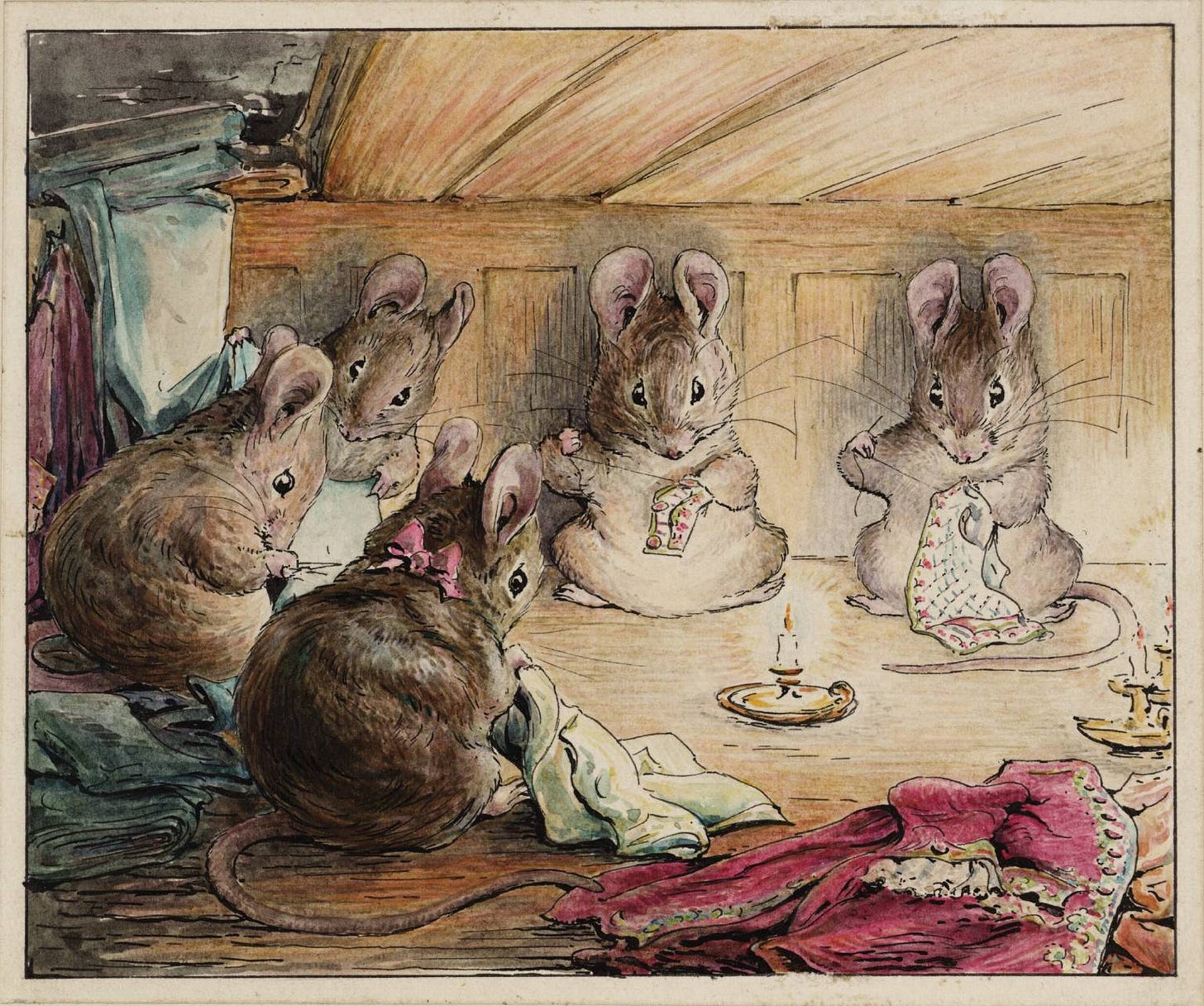On the Matter of Proper Garden Attire
By Madame Rosette Lacewing (With practical annotations by Mrs. Nutkin)
(With apologies to one Monsieur T. Doolan)
Fashion in the Garden is, like all things of true worth, a matter of both art and practicality. While our cousins in the grander gardens of Europe might focus on elaborate constructions of butterfly wing and moonbeam silk, we maintain a certain practical elegance that befits our particular society. One must, after all, consider the practical implications of morning dew on delicate fabrics.
Let us begin with everyday wear. A proper Garden mouse should maintain a wardrobe suitable for various daily activities. For gentlemice engaged in scholarly pursuits, I recommend waistcoats of pressed flower petals, carefully selected for both durability and seasonal appropriateness. Rose petals are quite fashionable for summer wear, while autumn calls for more substantial materials such as carefully cured maple leaves.
(Note from Mrs. Nutkin: One must consider the practical implications for tea service. Certain petal-weaves are particularly susceptible to seed-cake crumbs.)
Ladies of distinction might consider morning dresses of spidersilk, though I insist upon proper treatment with dewdrop starch to maintain appropriate structure. The current fashion favors overlays of gossamer, particularly for afternoon garden parties, though one must be mindful of the wind. Nothing quite disrupts proper social protocols like having one's gossamer overlay catch an unexpected breeze.
For those engaged in artistic pursuits, I have developed a line of specialized smocks that incorporate pockets for various pigments and tools. The Souris Luminaires of Giverny have been particularly appreciative of my designs for light-catching gear, though I maintain that their insistence on iris-petal formal robes is perhaps a touch theatrical for our more modest Garden.
(Further note from Mrs. Nutkin: The practical storage of light-catching equipment presents unique challenges to proper laundry protocols. Most irregular stains!)
Special occasions naturally require particular attention. For the annual Poetry Festival, I recommend ensembles that incorporate pressed verses between layers of morning-gathered spidersilk. The effect is both aesthetically pleasing and practically useful, as one always has an appropriate quote at hand. Wedding attire traditionally features dewdrop embroidery on moonflower petals, though I have recently begun experimenting with pressed moonlight for particularly elegant effects.
The matter of proper seasonal transition cannot be overlooked. One must consider not just the practical implications of changing weather, but the magical requirements of different Garden activities. Librarians, for instance, require specialized pockets for carrying various reference materials, while memory-keepers need fabrics that won't interfere with the delicate process of preserving moments in jars.
(Mrs. Nutkin interjects: The proper maintenance of specialized pockets requires strict adherence to established cleaning protocols. Most essential for scholarly organization!)
Accessories deserve particular attention. Gentlemice of distinction should maintain a selection of properly pressed cravats, preferably treated with moonlight starch for optimal structure. Ladies might consider delicate shawls woven from carefully collected cobwebs, though these require regular refreshing with morning dew to maintain their proper drape.
The question of hats is, of course, essential. Protection from both sun and rain must be considered, particularly for those engaged in Garden maintenance. I recommend constructions of sturdy oak leaves for practical wear, while social occasions might call for more elaborate creations incorporating pressed flowers and, for particularly distinguished events, perhaps a tasteful arrangement of captured starlight.
(Mrs. Nutkin notes: The storage of ceremonial headwear presents unique challenges to proper household management. One must consider the implications of starlight-enhanced millinery on regular dusting protocols.)
A word must be said about proper magical attire. Those engaged in memory-keeping require specialized fabrics that won't interfere with the preservation process. Light-catchers need materials that can withstand various artistic experiments, while those working with the Library's more adventurous volumes must consider the practical implications of books that occasionally attempt dramatic escapes.
For evening wear, I have recently developed a technique for incorporating properly preserved firefly light into delicate embroidery. The effect is both elegant and practical, providing gentle illumination for night garden events while maintaining appropriate sophistication.
One cannot overlook the importance of proper footwear. While many Garden mice prefer the natural approach, those engaged in more formal activities might consider carefully crafted leaf-shoes, particularly for events involving extensive standing. The annual Garden Ball, for instance, requires both durability and elegance in one's dancing shoes.
(Final note from Mrs. Nutkin: The maintenance of leaf-shoes presents unique challenges to proper storage protocols. Most essential to consider seasonal variations in durability!)
In conclusion, Garden fashion must always balance the practical requirements of our society with the natural elegance that befits our distinguished community. Whether selecting everyday wear or preparing for special occasions, one must consider both magical implications and practical concerns.
Though I must insist that Mr. Thistledown's recent experiment with self-organizing cravats, while theoretically interesting, falls somewhat outside the bounds of proper fashion protocols. There are, after all, some standards that must be maintained.
-- From the personal style guide of Madame Rosette Lacewing, carefully preserved in the Library's fashion section between a volume on proper petal-pressing techniques and a rather adventurous treatise on experimental hat construction that occasionally tries to redesign itself.



